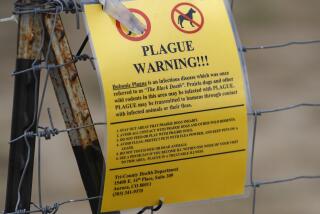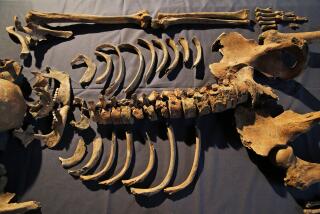Ancient ancestor of the bacteria that causes plague found in 5,000-year-old human remains
- Share via
In an ancient grave in Sweden, scientists have unearthed the oldest known strain of a deadly bacteria that has killed millions of people over thousands of years.
They call it Yersinia pestis. You may know it as the plague.
The new discovery suggests that the microscopic bacteria has been wiping out great swaths of the human population for more than 5,000 years — destroying empires, spurring political uprisings and leaving a permanent mark on regional gene pools.
“What we found in the Swedish grave site is not only the oldest sample of the Y. pestis genome but also the oldest version of the genome,” said Simon Rasmussen, a metagenomics researcher at the Technical University of Denmark, who led the work. “Think of it as the root of the tree.”
The oldest recorded plague pandemic, known as Justinian’s Plague, dates to 541 AD. Over the course of 200 years, it killed more than 25 million people across the Byzantine Empire, hitting the capital city of Constantinople especially hard.
The next major plague pandemic, known as the Black Death or the Great Plague, started in China in 1334 and spread along trade routes to Constantinople before reaching Europe in the 1340s. It also claimed the lives of an estimated 25 million people, including about half the population of Europe, according to researchers at the Centers for Disease Control and Prevention. Some towns weren’t left with enough survivors to bury the dead.
The third major outbreak, known as the Modern Plague, took root in China in the 1860s. It popped up again in Hong Kong in 1894 and spread to port cities around the world over the next 20 years, carried by stowaway rats on steamships. It was during this pandemic that scientists discovered the bacterial source of the disease, and that it is spread by fleas that pick it up from rats and pass it on to humans. Even with that knowledge, however, plague still managed to cause 10 million deaths.
Rat-associated plague can still be found in populations of ground squirrels and other small mammals in the Americas, Africa and Asia. It is now under control in most urban areas across the globe, and if it’s caught early enough, it can be treated with antibiotics. From 2010 to 2015, there were 3,248 human cases of plague reported worldwide and 584 deaths from the disease, according to the World Health Organization.
The new study, published Thursday in the journal Cell, reveals that the relationship between humans and plague goes back even further than scientists had realized. The bacteria identified by Rasmussen and his colleagues may represent a previously unknown outbreak of plague that struck Europe as much as 5,700 years ago.
The researchers already knew that the population of Europe plummeted 5,000 to 6,000 years ago, after it had grown for thousands of years. This sudden plunge is known as the Neolithic decline, and its cause is still up for debate.
Rasmussen and his colleagues wondered whether a plague pandemic could have been responsible.
“We were thinking, ‘Where have we seen this drop before?’ and that got us thinking about the Black Plague,” he said.
The disease was known to have existed across Eurasia at the dawn of the Bronze Age, which started around 4,500 years ago, but there was no evidence of its existence earlier than that.
To see if the plague was in Europe at the end of the Neolithic period, the group turned to databases of DNA extracted from ancient human remains — specifically, ancient teeth.
Because blood circulates through the center of our teeth, Rasmussen said, it is possible to detect the DNA of pathogens that were present in a person’s bloodstream at their time of death by examining a tooth sample.
“If you die from it and it’s in your blood,” he said, “then we can find it.”
After scanning for genetic sequences resembling modern-day Y. pestis, the group eventually found a match. It was in DNA extracted from the tooth of a 20-year-old woman who died in western Sweden between 5,040 and 4,867 years ago.
“This really surprised us,” Rasmussen said. “It was the oldest plague sample ever found.”
Next, the authors compared the newly discovered Y. pestis genome with 150 other plague samples that spanned thousand of years, going back all the way to the Bronze Age. This analysis revealed that the strain from the Swedish woman was closer to the origin of Y. pestis than any other, and therefore could inform scientists about the first plague ancestor from which all subsequent strains evolved, Rasmussen said.
How could this be? The Swedish woman lived in a small farming community, far from the center of the Neolithic world. Plague thrives in environments where large groups of people live in close quarters, share space with animals and stored food, and contend with poor sanitary conditions.
None of that explains how this woman contracted the disease.
So the researchers looked beyond genetics and considered the archaeological histories of human populations from the time period.
Although the young Swedish woman did not live in prime plague territory, there were other places in Europe where the disease could have flourished in the Neolithic era, Rasmussen said. These were the mega-settlements of the Trypillia Culture, built between 6,100 and 5,400 years ago and located in present-day Ukraine, Romania and Moldova. The largest of these settlements was home to as many as 20,000 people.
Archaeologists have shown that these settlements were abandoned and burned about once every 150 years. Usually, subsequent generations rebuilt right on the ashes of the previously destroyed buildings. Why the original structures were burned has never been explained.
Using the new findings as a guide, the researchers propose that the plague first evolved in these mega-settlements, morphing from a relatively benign stomach bug to a deadly microscopic killer around 5,700 years ago, around the time when the Swedish strain diverged from all others then in existence. This could explain the periodic burning of the buildings — perhaps they were set aflame to eradicate the disease.
The authors also suggest that the plague made its way from these settlements to the small Swedish farming village thanks to a vast trade network that was made possible by the recent expansion of animal-pulled wagons. As the disease spread along trade routes throughout the continent, it could have caused the Neolithic decline.
It’s a good story, but not everyone is buying it.
“The report of the new strain is really interesting, but a connection to the Trypilla Culture is, from my perspective, not a given,” said Ben Krause-Kyora, a biochemist and archaeologist at Kiel University in Germany.
He noted that there was currently no evidence of Y. pestis from grave sites in the mega-settlements, nor have archaeologists encountered a sudden uptick in burials of the young and the elderly in those communities, as one might expect to see during a pandemic.
In addition, the increased use of the wheel would not necessarily have helped spread plague to the extent that the authors suggest, he said. The DNA sequence of the Y. pestis that was found in Sweden suggests it was not yet capable of being easily transmitted by fleas living on infected rats that might stow away on a cart. The strain present in the Neolithic Era would have spread from person to person at a much slower rate, so it wouldn’t have impacted great swaths of the population at once.
Johannes Krause, a biochemist and director of the Max Planck Institute for the Science of Human History in Germany agreed that there was not enough evidence to suggest the ancient strain evolved in the mega-settlements.
“This is wild speculation,” Krause said.
The authors concede they still have a lot more work to do to fortify their argument that they may have discovered the first plague pandemic.
“This is just what we have now based on the data,” Rasmussen said. “Of course there are many more things we would like to know.”
For instance, turning up evidence of Y. pestis in one of the mega-settlements would strengthen their hypothesis, he said. It would also help to find the bacterium in other Neolithic communities across Europe, so they could create a more detailed picture of how the disease spread, and the extent of its impact on the population at the time.
In the meantime, the authors are already thinking about what to analyze next.
“There are a lot of ancient genomes coming out every month,” Rasmussen said. “And we could search for other pathogens as well. It’s just about looking.”
Do you love science? I do! Follow me @DeborahNetburn and “like” Los Angeles Times Science & Health on Facebook.
MORE IN SCIENCE







